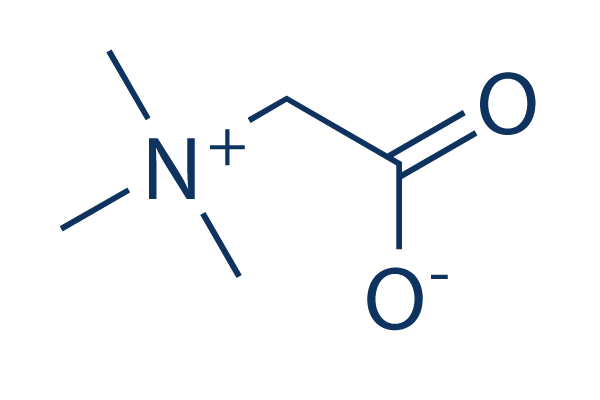|
受注:045-509-1970 |
技術サポート:[email protected] 平日9:00〜18:00 1営業日以内にご連絡を差し上げます |
化学情報

|
Synonyms | trimethylglycine, glycine betaine, lycine, oxyneurine | Storage (From the date of receipt) |
3 years -20°C powder 1 years -80°C in solvent |
| 化学式 | C5H11NO2 |
|||
| 分子量 | 117.15 | CAS No. | 107-43-7 | |
| Solubility (25°C)* | 体外 | Water | 100 mg/mL (853.6 mM) | |
| DMSO | 23 mg/mL (196.32 mM) | |||
|
* <1 mg/ml means slightly soluble or insoluble. * Please note that Selleck tests the solubility of all compounds in-house, and the actual solubility may differ slightly from published values. This is normal and is due to slight batch-to-batch variations. |
||||
溶剤液(一定の濃度)を調合する
生物活性
| 製品説明 | Betaine (trimethylglycine, glycine betaine, lycine, oxyneurine), a methyl derivative of glycine first isolated from sugar beets, has been shown to have potential benefits for fighting heart disease, improving body composition, and helping promote muscle gain and fat loss because of its abilities to promote protein synthesis in the body. |
|---|---|
| in vitro | Betaine shows negligible cytotoxicity even after long-term exposure of cells. It is rich in abundant microorganisms, plants, and animals. In human serum, the resting concentration of betaine ranges from ~2.3 to 8.2 mg/L. As a well-known osmoprotectant, betaine is able to protect cells against osmotically induced inactivation. Betaine could work as a nontoxic CPA (Cryoprotectants) and enable cells to survive ultrarapid cryopreservation to achieve superior cell survival efficiency. It is found that cellular uptake of betaine is ultra-rapid for intracellular protection during the freezing process[1]. Betaine stabilizes corneal epithelial cell volume under hyperosmotic stress and limits hyperosmotic stress-induced HCLE apoptosis[3]. |
| in vivo | Betaine (glycine betaine or trimethylglycine) plays important roles as an osmolyte and a methyl donor in animals. In humans, betaine is obtained from the diet or from its metabolic precursor choline. Betaine is utilized as a methyl donor in a reaction that converts homocysteine into methionine via betaine-homocysteine methyltransferase. Betaine also plays a role in osmotic regulation in the kidneys, which are routinely exposed to high extracellular osmolarity during normal operation of the urinary concentrating mechanism. Furthermore, dietary betaine suppresses the activation of nuclear factor-κB (NF-κB) with oxidative stress, and the protein expression of proinflammatory molecules such as cyclooxygenase-2 (COX-2), inducible nitric oxide synthase (iNOS), and tumor necrosis factor (TNF)-α in aged rat kidneys. Betaine has protective effects against LPS-induced memory impairment that are mediated through unique mechanisms involving betaine actions on GAT2, which is involved in the development of memory impairment, without affecting proinflammatory molecules or glial markers[2]. |
プロトコル(参考用のみ)
| 細胞アッセイ | 細胞株 | Human corneal limbal epithelial (HCLE) cells |
|---|---|---|
| 濃度 | 5 or 10 mM | |
| 反応時間 | 16 h | |
| 実験の流れ | Human corneal limbal epithelial (HCLE) cells exposed to culture medium for 16 h at 300 mOsm (isotonic) or 500 mOsm (hyperosmotic) in the presence or absence of betaine (5 or 10 mM) are evaluated for cell volume changes; cell viability; and apoptosis. | |
| 動物実験 | 動物モデル | Male ddY strain mice |
| 投薬量 | 0.081, 0.163, or 0.326 mmol/kg | |
| 投与方法 | s.c. |
参考
|
Selleckの高級品が、幾つかの出版された研究調査結果(以下を含む)で使われた:
| Reactivated endogenous retroviruses promote protein aggregate spreading [ Nat Commun, 2023, 14(1):5034] | PubMed: 37596282 |
| Reactivated endogenous retroviruses promote protein aggregate spreading [ Nat Commun, 2023, 14(1):5034] | PubMed: 37596282 |
長期の保管のために-20°Cの下で製品を保ってください。
人間や獣医の診断であるか治療的な使用のためにでない。
各々の製品のための特定の保管と取扱い情報は、製品データシートの上で示されます。大部分のSelleck製品は、推薦された状況の下で安定です。製品は、推薦された保管温度と異なる温度で、時々出荷されます。長期の保管のために必要とされてそれと異なる温度で、多くの製品は、短期もので安定です。品質を維持するが、夜通しの積荷のために最も経済的な貯蔵状況を用いてあなたの送料を保存する状況の下に、製品が出荷されることを、我々は確実とします。製品の受領と同時に、製品データシートの上で貯蔵推薦に従ってください。
